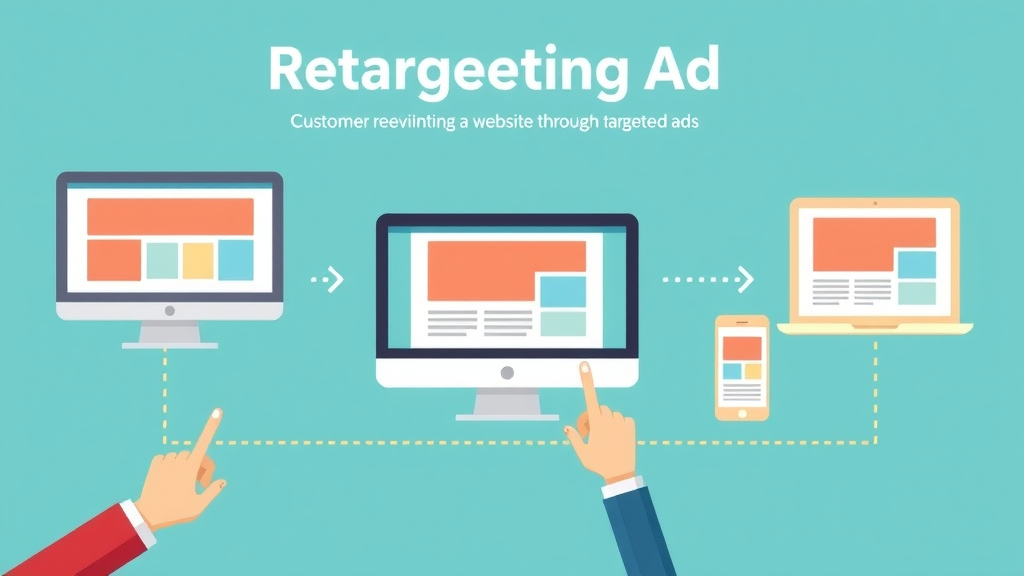Did you know over 98% of website visitors don’t convert on their first visit? For local businesses eager to make the most of every online ad dollar, understanding how to set up retargeting ads for local businesses is a game changer. Retargeting campaigns put your brand back in front of potential customers—right when they’re ready to buy. In this guide, you’ll discover exactly how to launch and optimize cost-effective retargeting ads that transform casual site visitors into loyal buyers. Whether you’re a retail owner, service provider, or a food & beverage hotspot, this blueprint gives you practical steps, time-saving tips, and platform comparisons so you can turn missed opportunities into real revenue—fast.
Unlocking the Power of Retargeting Ads: Why Local Businesses Can't Afford to Ignore This Strategy
Every small business faces the challenge of reaching potential customers who have already shown interest in their products or services. By focusing on how to set up retargeting ads for local businesses , owners can re-engage those website visitors and dramatically boost their conversion rate. Remarketing campaigns help local companies maintain brand awareness, gently nudging people who’ve already visited your website to come back at the perfect moment. The beauty of retargeting ads is their ability to keep your business top-of-mind, especially as potential customers compare options in a competitive digital market. Real-world examples consistently show that retargeting campaigns outperform standard online ads for small businesses targeting their local communities. Whether a user abandoned a shopping cart or glanced at your services page, a targeted ad can remind them of what brought them to you in the first place, increasing their chances of returning and converting.
Local businesses thrive on trust and recognition. Retargeting ads serve as gentle reminders to consumers who may be weighing several options or got distracted before checking out. By implementing these digital marketing strategies through Facebook ad, Google Ads, or display ad networks, small businesses can strengthen their position in the marketplace. Not only do these techniques amplify brand visibility, but they also provide measurable boosts in website visitor engagement and retention, opening new avenues for growth on a modest budget.

Startling Retargeting Ad Statistics That Highlight Success for Small Businesses
Consider this: “ 98% of website visitors don’t convert on their first visit—retargeting ads put your brand back in front of potential customers at the perfect moment. ” This figure alone demonstrates why every small business should prioritize retargeting campaigns in their digital marketing strategy. Recent studies show that retargeting ads can increase ad engagement rates by up to 400% compared to standard display ad campaigns. Furthermore, businesses that utilize platforms such as Facebook Ads and Google Ads for remarketing report a 70% higher likelihood of converting previous site visitors into actual customers.
Not only do these statistics highlight the immense potential for local businesses, but they also reveal that retargeting campaigns are cost-effective. For every dollar spent on a well-optimized retargeting ad, the average return on investment (ROI) is significantly higher than traditional online ad tactics. This strategy lets small business owners stretch their budgets while getting in front of customers most likely to convert, making retargeting one of the top tools in today’s digital marketing arsenal.
“98% of website visitors don’t convert on their first visit—retargeting ads put your brand back in front of potential customers at the perfect moment.”
- The exact steps for how to set up retargeting ads for local businesses
- How retargeting ad campaigns increase conversion rates for small businesses
- Best practices for boosting brand awareness and reaching potential customers through Facebook ads, Google Ads, and other platforms
- Proven strategies to track website visitors and segment your custom audience for maximum ROI
- Real-world examples of retargeting campaigns tailored to local business owners
| Platform | Audience Reach | Ad Formats | Cost Range | Best For |
|---|---|---|---|---|
| Google Ads | Extensive (Web, YouTube, Display Network) | Display, Video, Search | $0.25–$2.00 per click | All industries, high web traffic sites |
| Facebook Ads | Social media users, local audiences | Image, Video, Carousel, Stories | $0.20–$1.50 per click | Retail, services, local engagement |
| Instagram Ads | Visual-centric, younger demographics | Image, Video, Stories | $0.40–$2.00 per click | Fashion, restaurants, events |
| Display Ad Networks | Broad web, niche sites | Banners, Native, Video | $0.15–$1.00 per click | Brand exposure, banner retargeting |

Step-by-Step Process: How to Set Up Retargeting Ads for Local Businesses
Mastering how to set up retargeting ads for local businesses can set you apart from your local competitors. The step-by-step process starts with understanding the foundational concepts behind retargeting ads and remarketing campaigns, then continues with technical implementation and smart audience segmentation for impactful results. Unlike regular online ads, retargeting campaigns use tracking codes and custom audience creation to follow people through their journey from a website visitor to a paying customer. This allows small businesses to deploy marketing campaigns that deliver repeat exposure—vital for increasing conversion rate and nurturing lasting brand awareness within their community.
Each step, from identifying your audience and installing tracking codes to choosing the right platform (like Facebook Ad or Google Ads), is designed to be manageable—even for busy business owners. As you dive deeper, you’ll learn how to set up and optimize every detail, so your ad spend drives measurable growth without requiring a digital marketing agency on retainer. Let’s break down these steps so you can set up your first retargeting campaign with confidence, tapping into the same tools that top local brands use to thrive online.
Understanding Retargeting: A Small Business Owner’s Guide
The basics of retargeting are refreshingly simple yet incredibly powerful. If you've ever browsed a local store’s website and then seen their ads while scrolling through Facebook or reading the news, you’ve experienced a retargeting ad in action. The magic happens because, after someone has visited your website, a tracking pixel or cookie identifies them as a potential customer for future targeted ads on various platforms. This enables small businesses to remind site visitors about products or services they viewed, nudging them to return and complete their journey.
For small businesses, retargeting creates multiple touchpoints with potential customers who have shown interest but haven't yet converted. Businesses can set up remarketing campaigns on major media platforms like Google Ads, the Facebook ad ecosystem, and other display ad networks. This technique is effective because it feels personalized and timely, increasing the likelihood of converting website visitors into buyers or clients. Understanding these basics ensures you make informed decisions as you set up and run your campaigns.
The Core Mechanics of Retargeting Ads and Remarketing Campaigns
Retargeting ads work through a clever but straightforward mechanism: when someone visits your website, a piece of code—often called a pixel or tag—is installed on your web pages. This code tracks interactions and catalogues visitors, allowing you to create a custom audience list for future marketing campaigns. Once your audience is built, you can show highly relevant, targeted ads, often referred to as remarketing ads, to users across platforms like Google Ads or Facebook ad placements.
Remarketing campaigns can be structured to segment site visitors based on actions taken—viewing specific pages, spending time on product details, or even adding items to a shopping cart. With this data, small businesses can craft a tailored digital marketing strategy that shows targeted ads only to those most likely to convert. This not only saves budget but also increases campaign relevance, as the ads are shown to audience segments with proven interest in your offerings.

Creating a Custom Audience: Identifying Your Potential Customers and Website Visitors
Creating a custom audience is at the heart of effective retargeting. Platforms like Facebook Ads and Google Ads make it easy for local business owners to segment website visitors and tailor retargeting ad messages for each group. By focusing on those who’ve interacted with your site but haven’t yet converted—your “warmest” potential customers—you direct your marketing spend at the most high-value prospects. Custom audiences can include people who visited a certain product page, started checkout but didn’t complete, or spent significant time on your services section—indicating real interest in what you offer.
Segmenting your audience like this allows for extremely targeted ad campaigns. For example, potential customers who abandoned their shopping cart might see one type of ad, while first-time visitors get another. This approach not only increases your conversion rate but also boosts brand awareness among those most likely to advocate for your business. The more specific your audience segments, the more effective your retargeting ads will become—translating to better results for your small business marketing strategy.
Installing Tracking Codes for Retargeting Campaigns on Your Local Business Website
The technical set-up for retargeting ads starts with installing the appropriate tracking codes (also called 'pixels' or 'tags') on your business website. For Google Ads, you’ll use the Google remarketing tag, while Facebook Ads use the Facebook Pixel. These snippets of code are placed in the header of your site and begin compiling a list of visitors instantly. This enables you to track site visitor behavior—essential data for building your custom audience and launching targeted ad campaigns.
While the process is straightforward, accuracy matters: even a small oversight can impact campaign performance. Double-check that the code is active on every relevant page, especially those that indicate a high intent to purchase (like product pages or contact forms). Many platforms provide step-by-step guides and diagnostics tools to make certain your implementation is bulletproof. Once installed, you'll have the foundation to launch retargeting campaigns that connect with potential customers whenever they engage with your brand online.
- Access to your business website’s backend or webmaster support
- Ad platform accounts (e.g., Google Ads, Facebook Ad Manager)
- Correct installation of tracking pixel/code across key pages
- Privacy updates and tracking notifications for site visitors
- Defined custom audience segments for each remarketing campaign

Choosing the Right Retargeting Ad Platform for Local Businesses
Selecting the appropriate platform for your retargeting ads is crucial for local business success. Google Ads, Facebook Ads, and other display ad networks each offer unique features that cater to different audience demographics and marketing goals. Google Ads retargeting is ideal for broad web reach, allowing small businesses to connect with potential customers as they browse news sites, YouTube, and partner blogs. In contrast, Facebook ad retargeting provides exceptional targeting within your local community, leveraging user data and engagement trends on social media.
For small businesses looking for scalability and versatility, combining multiple platforms can be powerful. Experimenting with Instagram Ads and display ad networks can increase brand awareness, especially among visually-oriented audiences. Reviewing each platform’s analytics and success stories helps you understand where your potential customers spend most of their time—enabling you to allocate ad spend for maximum impact and ROI. Understanding these options ensures your retargeting campaign choice matches your audience and business objectives.
Google Ads Retargeting: Setup, Best Practices, and Success Examples
Google Ads is a premier choice for small businesses investing in retargeting. The platform’s vast reach through search, display ad, and YouTube placements makes it possible to re-engage previous website visitors wherever they go online. Setting up a Google remarketing campaign starts with the installation of the Global Site Tag on your website and the creation of audience lists based on specific website actions—such as product page views or shopping cart abandonment.
Best practices include segmenting audience lists, setting competitive bids for high-intent visitors, and using dynamic ad creative that adapts to prior browsing activity. Success stories often highlight local businesses that measured up to a 60% increase in conversion rate after implementing Google Ad retargeting. Businesses offering products or services benefit from the deep analytics, robust targeting, and automation tools available—making Google Ads a go-to for scaling retargeting efforts efficiently.
Facebook Ads for Retargeting: Local Business Strategies and Assets
Facebook Ads offer local businesses remarkable potential for building brand awareness and driving conversions. With advanced targeting tools and the Facebook Pixel, you can create custom audiences from site visitors, email lists, or app users—and then serve personalized ads to users as they scroll through their newsfeeds or stories. For small businesses, the Facebook ad interface makes it easy to launch retargeting campaigns, test creative, and analyze results without deep technical knowledge.
Effective strategies often involve segmenting ad sets for different audience segments—such as repeat visitors, recent leads, or shoppers who left items in their cart. Use clear, compelling calls-to-action and authentic imagery that reflects your local business values. Many small businesses enjoy rapid, measurable results—sometimes within days—thanks to Facebook’s location-based targeting and affordable cost structure, making it one of the best media platforms for retargeting ad success.

Expanding Reach: Leveraging Social Media and Display Ads for Small Businesses
While Facebook Ads and Google Ads dominate the retargeting landscape, don’t overlook the power of additional social media and display ad networks. Instagram is highly effective for businesses in visual niches, such as restaurants, fashion, or events. Meanwhile, display ad networks—often accessed via Google’s Display Network or independent providers—allow your ads to run on a wide assortment of local blogs, forums, and news sites that potential customers frequent.
Incorporating a multi-channel approach not only multiplies your impressions but also reinforces your brand messaging across different touchpoints. Modern marketing campaigns should be versatile, adjusting ad formats and creatives to fit the context of each platform (image, video, interactive banners). The cross-platform strategy ensures your small business stays top-of-mind, regardless of where audience members browse, making your retargeting campaign resilient and effective in today’s diverse digital market.
Crafting Effective Retargeting Ads for Local Businesses
Developing a winning creative strategy is crucial for how to set up retargeting ads for local businesses . Every targeted ad displayed to a potential customer should feel personalized and relevant. From eye-catching visuals to persuasive copy, your ads should encourage previous website visitors to re-engage and complete their purchase or inquiry. Focusing on audience segments—such as shopping cart abandoners or repeat visitors—enables you to adjust your messaging for maximum impact. By understanding your audience’s pain points, you can create retargeting ads that move them closer to conversion with every impression.
Small business owners should also keep their creative assets fresh and on-brand. Use vibrant imagery, authentic local themes, and compelling value propositions. Test different copy and calls-to-action to discover what resonates best with each segment. By continually customizing your remarketing campaign creative, you’ll amplify your click-through and conversion rate while sustaining your brand’s credibility and approachability in your local market.
Message Tailoring for Potential Customers: Driving Conversions with Targeted Ads
Tailoring your message is a make-or-break point for retargeting success. Address your potential customers by speaking directly to their needs—remind shoppers about items left in their shopping cart or highlight service benefits unique to your local area. Use targeted ad copy that asks relevant questions (“Still thinking about that new haircut?”) or offers incentives (“Come back and enjoy 10% off your next visit!”) to overcome hesitation and drive actions. The more relevant your messaging, the more likely a website visitor will return and convert.
Leveraging urgency, social proof, and localized content also amplifies results. Showcase customer testimonials, recent reviews, or examples of neighbors who have used your services. The key is ensuring every interaction through a retargeting ad feels like a genuine, friendly nudge rather than a hard sales push—building long-term trust and maximizing ROI for your marketing strategy.

Visual & Copy Best Practices for Small Business Retargeting Campaigns
Effective retargeting campaigns rely on both striking visuals and concise, persuasive copy. For small businesses, visuals should reflect your actual storefront, staff, or products/services—personal touches resonate more than generic stock photos. Keep the design clean and use high-contrast colors for readability, especially on mobile devices where many targeted ads are viewed. For copy, brevity is key: focus on the unique benefits that set your business apart and reinforce your value proposition with a compelling call-to-action (“Book your appointment today!” or “Browse our new arrivals!”).
Consistency in messaging across platforms improves brand recall and trust, essential for retargeting ads to achieve their full potential. Regularly update your ad creative to avoid “banner blindness” and test new variations based on audience engagement data. Remember, the goal is to make your brand feel familiar and inviting—encouraging website visitors to take the next step, whether it’s making a purchase, signing up for a newsletter, or booking a consultation.
Segmenting Custom Audiences to Target Shopping Cart Abandoners and Site Visitors
Segmentation can dramatically improve retargeting campaign results. By using your tracking tools to divide your audience into different segments—repeat visitors, new leads, or those who abandoned a shopping cart—you can tailor ads more precisely. For example, shopping cart abandoners may respond best to reminders or exclusive discount offers, while first-time website visitors might need more information about your reputation or unique selling points.
Platforms like Google Ads and Facebook allow for detailed audience segmentation in ad manager interfaces. Analyze your site data to group users by actions taken, time spent on site, or pages viewed. Dynamic creative templates can automatically insert products or services viewed, personalizing each targeted ad for maximum impact. This granular approach leads to higher engagement, better conversion rates, and increased ROI for every dollar spent on your digital marketing strategy.
- Use dynamic product ads to show site visitors the exact items they viewed
- Test different offers (discount, free trial, loyalty rewards) per audience segment
- Update ad creative monthly to avoid creative fatigue
- Include clear, action-oriented CTAs in every ad
- Leverage customer testimonials or local awards in your ad visuals for added trust
| Audience Segment | Example Ad Message |
|---|---|
| Shopping Cart Abandoners | “Forget something? Your items are still in your cart—complete your order and get 10% off!” |
| Repeat Visitors | “Welcome back! Discover new offerings and exclusive deals just for you.” |
| New Leads | “See why [Local Business Name] is the community’s favorite—book your first visit today!” |

Optimizing Retargeting Campaigns for Small Business Growth
Setting up your campaigns is only the beginning—the real gains come with continuous optimization. Local businesses should routinely analyze performance data, test different ad variations, and refine their audience segments. By closely monitoring metrics such as click-through rate and conversion rate, you’ll spot opportunities for improvement and ensure your marketing spend delivers the best possible ROI. Small refinements, like adjusting your targeting parameters or updating creative, can make a substantial difference in campaign effectiveness.
Another key to growth is integrating your retargeting campaigns into your broader marketing strategy. This means syncing up email efforts, social media content, and in-store promotions with your online ads for a cohesive brand experience. As you collect more data and run A/B tests, transition from custom audiences to lookalike audiences—expanding your reach to people similar to your most loyal customers. The result? Sustained business growth powered by smart, targeted digital marketing efforts.
Tracking Website Visitors and Measuring Conversion Rate Improvements
Success begins with measurement. Use analytics tools from Google Ads and Facebook Ad Manager to track every website visitor journey, pinpointing where users drop off and where ads are most effective. Focus on metrics such as impressions, clicks, and, most importantly, conversion rates to understand campaign ROI. By setting up clear goals for each retargeting campaign—such as purchases, form completions, or phone calls—you can measure improvements over time and adjust budgets or creatives accordingly.
Small businesses often find that even a modest uptick in conversion rate can transform their monthly results. Set calendar reminders to review campaign data weekly, and don’t hesitate to pause underperforming ads while scaling up your best performers. By remaining data-driven, your retargeting efforts will consistently deliver measurable growth, increased website visitor engagement, and greater brand awareness in your local market.

A/B Testing Your Retargeting Ads for Better ROI
A/B testing is essential for optimizing your retargeting campaigns. For each audience segment, create two or more versions of your ad—test headlines, images, offers, or CTAs. Platforms like Google Ads and Facebook Ads offer built-in A/B testing tools, automatically serving variations to see which generates better click-through and conversion rates. Don’t just guess: data from real-time testing often leads to creative ideas that outperform initial assumptions.
Consistently review test results and iterate on successful concepts. Over time, you’ll be able to refine your campaign assets so they match the preferences of each potential customer segment. Remember, digital marketing is a dynamic process: what works today may need adjusting tomorrow, especially as you scale up spend or introduce new products or services.
Refining Audience Segments: From Custom Audience to Lookalike Audiences
As you gather more campaign data, leverage it to move beyond initial custom audiences. Many retargeting platforms, especially Facebook Ads, let you generate lookalike audiences —new users whose behavior closely matches those of your best existing customers. This strategy helps scale your marketing campaigns without diluting relevance, letting you reach greater pools of high-potential leads in your region.
Periodically revisit your audience segmentation strategy. Update your targeting criteria based on the latest trends, product launches, and seasonal interests. Track the conversion rate across each audience segment and reallocate budget to those with the highest ROI. Gradually, this approach builds a self-reinforcing cycle of growth, elevating your small business above local competitors through precision digital marketing.
Integration: How Retargeting Campaigns Fit into a Broader Marketing Strategy
Retargeting should never operate in isolation. Integrate it alongside email marketing , social media organic content, and special in-store promotions for the greatest impact. Share consistent messaging across all touchpoints, using retargeting ads to reinforce themes or urgent offers introduced through other channels. This multi-channel marketing strategy maximizes visibility and recall for your small business, creating touchpoints that drive both online and offline conversions.
Coordinate with your team to synchronize ad messaging with upcoming events, holiday sales, or loyalty programs. Use retargeting ads to follow up with online inquiries, reinforcing the human side of your business. Consistency, creativity, and data-driven optimization are the pillars of a modern, effective local business marketing strategy powered by retargeting.
Budgeting and Scaling: Making Retargeting Ads Work for Local Businesses
Smart spending is as important as smart targeting. Understanding the typical costs of retargeting campaigns, wisely managing your ad spend, and knowing when to scale are crucial for local business owners. Start with a conservative daily budget, monitor results closely, and increase investment in high-performing audience segments. Both Google Ads and Facebook Ads offer robust budget management features, letting you control overall spend while maximizing the coverage and frequency of your retargeting ads.
Budget allocation should reflect your unique business goals—such as boosting store visits, driving online bookings, or raising local brand awareness. Many local businesses discover that a modest regular spend on retargeting brings greater ROI than larger, less focused online ad campaigns. Track every dollar with platform analytics and always set thresholds to prevent overspending. As your campaigns grow, reinvest profits to expand reach and explore new platforms or creative ideas.
Typical Retargeting Ad Costs for Small Businesses
Retargeting ads for local businesses remain highly affordable, especially compared to traditional advertising. On average, Google Ads remarketing campaigns cost between $0.25 and $2.00 per click, while Facebook Ads retargeting usually falls in the $0.20 to $1.50 range. Display ad network prices may be lower still. Naturally, costs can vary by competition, target location, and the specificity of your audience segments. Keeping campaigns tightly focused on your custom audience assures you spend only to reach high-value prospects—maximizing every penny spent.
Use platform cost calculators to estimate spend and set realistic expectations. As your conversion rates rise and retargeting campaign ROI improves, you can incrementally increase your budget to capture more local market share—ensuring long-term business growth.
Managing Spend Across Google Ads, Facebook Ads, and Display Networks
To get the most out of your ad budget, allocate spend across platforms based on where your audience is most active. Track performance for each channel and adjust weekly. Many local businesses find that Facebook Ads excel in driving local foot traffic, while Google Ads are better for catching audiences at key decision moments. Display ad networks can help with brand recall and following upper-funnel site visitors, especially if paired with effective creative.
Tools within each media platform allow for granular control over daily caps, frequency, and bid strategies. Consider automating budget allocation based on real-time performance—letting high-converting ads receive more funding while pausing underperformers. Thoughtful budgeting ensures your retargeting campaigns support sustained small business growth without wasted resources.

Scaling Up: When and How to Grow Your Remarketing Campaigns
Once you achieve stable conversion rates with your initial retargeting campaigns, it's time to scale. This might include expanding your custom audience, targeting new lookalike audiences, or increasing daily ad spend to capture a larger share of local potential customers. Update your ad creatives routinely and explore cross-promotions through partnerships or local event sponsorships, leveraging digital marketing assets for both sponsors.
Be patient and strategic—monitor for diminishing returns and adjust creative or targeting as your reach broadens. Scaling can also mean extending your campaigns to seasonality (holidays, back-to-school promotions) or new service launches. A disciplined, optimized scaling strategy ensures continued revenue growth without jeopardizing efficiency or brand reputation.
- Over-targeting too broad or generic audiences
- Setting and forgetting campaign budgets
- Neglecting regular creative updates
- Failing to pause underperforming ads
- Ignoring data-driven optimization opportunities
“With the right budget allocation, even the smallest marketing campaigns can reach thousands of potential customers in your city.”
Case Studies: Successful Retargeting Campaigns for Small Businesses
Real-world success stories speak volumes. Across retail, service, and hospitality sectors, retargeting ads have empowered countless small businesses to maximize every website visit and drive steady growth. Below are snapshots from local businesses that have transformed their bottom line with savvy remarketing strategies.

Local Service Provider: Retargeting Ad Results and Lessons Learned
A local HVAC company integrated Facebook and Google display ads into their digital marketing mix. By targeting past website visitors with service reminders and seasonal offers, they increased appointment bookings 48% in just two months. Their secret? Rigorous audience segmentation and personalized ad creative that referenced local weather patterns and urgent needs—showing the power of hyper-local retargeting campaigns for service-based businesses.
Main lesson: Know your audience segments, and speak to them in context. A simple message delivered at the right time can drive impressive results, especially for small, locally known brands.
Retail Store: Boosting Conversion Rate and Brand Awareness with Remarketing
A family-owned boutique launched Google Ads and Facebook Ad retargeting to engage online browsers who visited but didn’t buy. Special offers and event invitations brought back hesitant shoppers, driving a 36% increase in conversion rate and boosting foot traffic at pop-up events. Consistent creative updates—showcasing new arrivals and happy customer testimonials—strengthened brand awareness, resulting in more word-of-mouth referrals in their local community.
The takeaway: Keep your messaging fresh and make every ad about serving the individual’s needs. Remarketing campaigns work best when they continuously reflect what your potential customers care about most.
Food & Beverage Business: Social Media Strategy Meets Retargeting Success
A local café paired Instagram and Facebook retargeting with daily specials and seasonal promos. By segmenting custom audiences (e.g., weekday lunch visitors, weekend brunchers), each targeted ad became more relevant—and turnout for events soared. Their retargeting campaign strategy led to a 28% higher redemption rate for online coupons versus regular social media posts alone.
Lesson learned: The integration of retargeting with ongoing social media engagement lets potential customers experience your business multiple times, cementing loyalty and frequent visits.
| Business Type | Conversion Rate (Before) | Conversion Rate (After) | Ad Spend ROI | Brand Awareness |
|---|---|---|---|---|
| Local Service | 8% | 12% | 4.7x | +60% |
| Retail Store | 3.2% | 4.4% | 3.9x | +35% |
| Food & Beverage | 15% | 19.2% | 5.2x | +46% |
People Also Ask
How to setup a retargeting ad?
Setting up a retargeting ad involves installing a tracking pixel (like the Facebook Pixel or Google Remarketing Tag) on your website. Once your custom audience is built, create an ad campaign specifically targeting those who have previously visited your site. Choose ad creative personalized to your audience and set your daily or campaign budget within your chosen ad platform. Monitor and optimize as data comes in for best results.
Step-by-Step Approach to Set Up Retargeting Ads for Local Businesses
Begin by choosing a platform (Google Ads, Facebook Ads, etc.), then create an account if you don’t have one. Next, install the relevant tracking code on every key page of your website, verify tracking is working, and start building your custom audience based on website visitors. After enough data is collected, design your ad creative, choose your target audience, and launch your campaign. Monitor conversions and adjust for ongoing improvement.
Are Facebook ads good for local businesses?
Yes, Facebook Ads are an excellent option for local businesses due to their advanced location and demographic targeting. With the Facebook Pixel, you can efficiently retarget past site visitors, engage new leads, and promote foot traffic or online bookings. The affordable pricing and robust analytics make Facebook Ads especially suitable for local businesses aiming to maximize ROI.
Evaluating Facebook Ads for Local Business Retargeting
Facebook Ads offer powerful tools for building custom and lookalike audiences. Their ad platform simplifies segmentation—meaning you can serve different creative to new leads, current customers, or shopping cart abandoners. With robust reporting, you can track each campaign’s ROI and make quick decisions to boost performance, making it a top choice for most local businesses looking to run retargeting campaigns.
How much do retargeting ads cost?
Retargeting ad costs vary by platform, audience, and competition. As a rule of thumb, expect costs between $0.20 and $2 per click on Facebook and Google. Display ad campaigns can be even more affordable. Budgeting is flexible—you can start with as little as $5 to $10 per day and scale up as your campaigns prove their effectiveness through increased conversion rates and sales.
Understanding Retargeting Ad Costs for Small Businesses
Retargeting ad costs are typically lower per conversion than standard campaigns since you're targeting warm leads. Adjust your budget by leveraging platform recommendations, A/B testing, and refining your custom audience. Monitor spend closely and prioritize high-performing segments to keep costs down while driving strong ROI for your small business.
How to create remarketing ads?
To create remarketing ads, first install the appropriate tracking code to collect audience data. Log into your chosen ad platform, build custom audience segments based on behavior (site visits, cart abandonment), then design text and images relevant to each group. Launch your campaign, analyze outcomes, and tweak strategy to continually improve conversion rates.
A Quick Guide for Creating Effective Remarketing Ads
Use clear, benefit-driven copy and compelling visuals that resonate with previous website visitors. Segment your audience and tailor offers or messages accordingly. Include a strong call-to-action and use platform analytics to A/B test different creative versions. Consistent monitoring and adjustment will yield the best results for your remarketing campaign.
Frequently Asked Questions about How to Set Up Retargeting Ads for Local Businesses
- Is retargeting only effective for e-commerce or also for local service businesses? Retargeting is effective for both e-commerce and local service businesses. Any business with a website or app can benefit from reminding past visitors to complete purchases, schedule appointments, or return for future services.
- Can small businesses set up retargeting ads without an agency? Yes! Most platforms provide user-friendly guides and dashboards so small businesses can launch and manage campaigns themselves. Many third-party tutorials and support groups are also available.
- Which platforms are best for local businesses to launch retargeting campaigns? Facebook Ads and Google Ads are most popular for local business retargeting. Instagram, YouTube, and display networks are also valuable, especially when targeting visually engaged audiences.
- How do you track website visitors and measure retargeting ad performance? Install platform pixels or tags (e.g., Facebook Pixel, Google Tag). Use dashboard analytics to monitor total visits, conversions, cost-per-click, and conversion rates—adjust your campaign for ongoing improvement.
Your Free Resource to Start Retargeting Ads for Local Businesses
Ready to grow your business? Book your free Marketing Strategy Session at https://imodagency1.com or call 5626207576
Act now: Install tracking codes, build your custom audience, launch your first retargeting ad, and watch your local business grow with every optimized campaign.
To effectively set up retargeting ads for your local business, consider the following resources:
- “Boost Your Local Business with Effective Retargeting Ads” ( blog.exactbuyer.com )
This article provides insights into targeting your local audience through retargeting ads, emphasizing the importance of understanding your local market and utilizing geo-targeting strategies.
- “How To Setup A Facebook Retargeting Ads Campaign (Tutorial)” ( reliablesoft.net )
This tutorial offers a step-by-step guide on creating a Facebook retargeting campaign, including setting up a Facebook Business page, installing the Facebook pixel, and creating custom audiences.
These resources will guide you through the process of setting up and optimizing retargeting ads to effectively re-engage potential customers and boost your local business’s growth.
 Add Row
Add Row  Add
Add 




Write A Comment